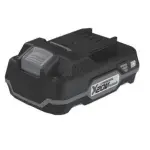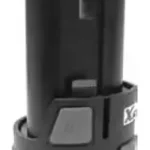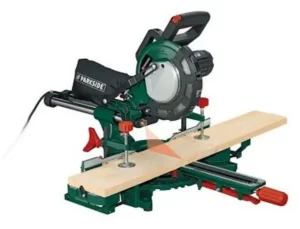

PARKSIDE MPKZ 2000 A1 Multifunction Sliding Cross Cut Mitre Saw
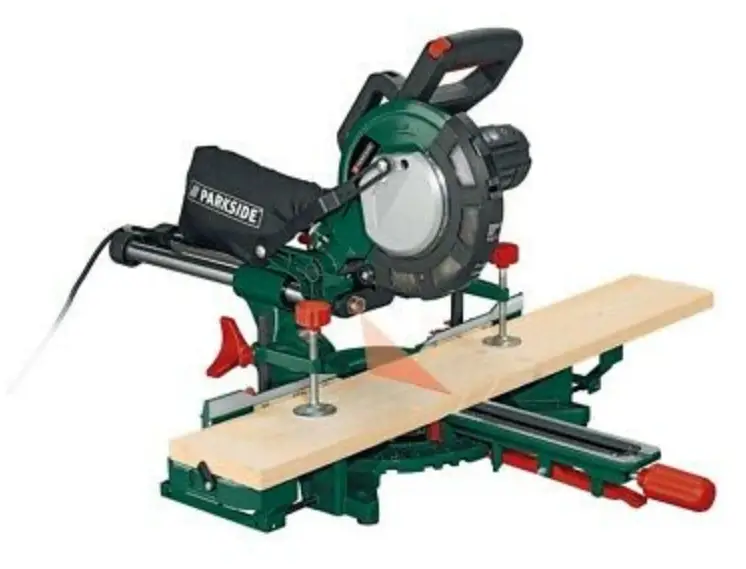
Before reading, unfold the page containing the illustrations and familiarise yourself with all functions of the device.
Explanation of the symbols on the equipment
Introduction
Manufacturer: scheppach
Fabrikation von Holzbearbeitungsmaschinen GmbH Günzburger Straße 69
D-89335 Ichenhausen
Dear customer,
We hope your new tool brings you much enjoyment and success.
Note:
According to the applicable product liability laws, the manufacturer of the device does not assume liability for damages to the product or damages caused by the product that occurs due to:
- Improper handling,
- Non-compliance of the operating instructions,
- Repairs by third parties, not by authorized service technicians,
- Installation and replacement of non-original spare parts,
- Application other than specified,
- A breakdown of the electrical system that occurs due to the non-compliance of the electric regulations and VDE regulations 0100, DIN 57113 / VDE0113.
Please consider:
Read through the complete text in the operating instructions before installing and commissioning the device.
The operating instructions are intended to help the user to become familiar with the machine and take advantage of its application possibilities in accordance with the recommendations.
The operating instructions contain important information
on how to operate the machine safely, professionally and economically, how to avoid danger, costly repairs, reduce downtimes and how to increase the reliability and service life of the machine.
In addition to the safety regulations in the operating instructions, you have to meet the applicable regulations that apply for the operation of the machine in your country.
Keep the operating instructions package with the machine at all times and store it in a plastic cover to protect it from dirt and moisture. Read the instruction manual each time before operating the machine and carefully follow its information. The machine can only be operated by persons who were instructed concerning the operation of the machine and who are informed about the associated dangers. The minimum age requirement must be complied with.
In addition to the safety instructions contained in this operat-ing manual and the specific regulations of your country,
the technical rules generally accepted for the operation of machines of the same type must be observed.
We accept no liability for damage or accidents which arise due to the non-observance of these instructions and the safety information.
Device description

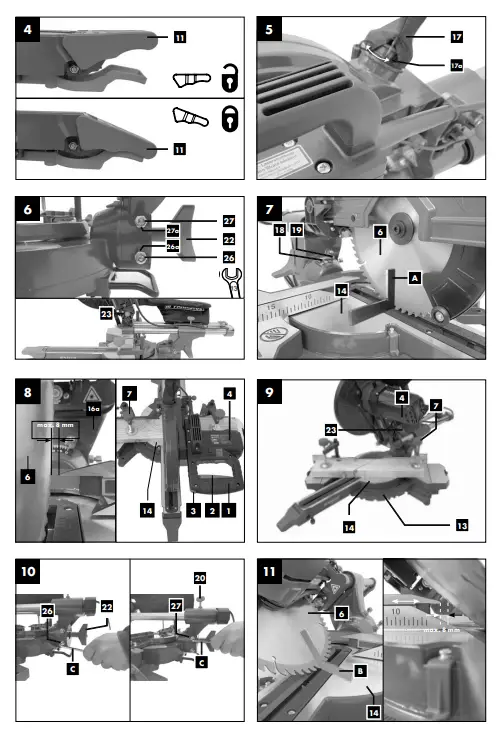
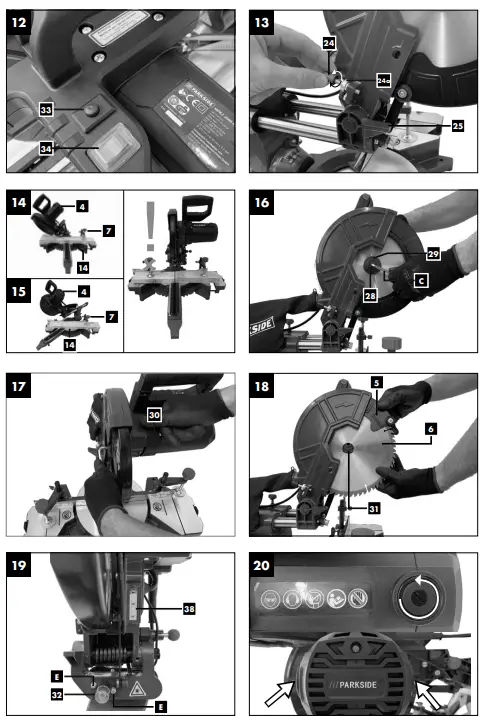
- Handle
- ON/OFF switch
- Lock switch
- Machine head
- Moving saw blade guard
- Saw blade
- Clamping device
- Wing screw
- Workpiece support
- Set screw for workpiece support
- Table insert
- Locking handle
- Pointer (mitre adjustment)
- Scale (mitre adjustment)
- Rotary table
- Fixed saw table
- Stop rail
- Movable stop rail
- Set screw
- Chip collection bag
- Extraction port
- Scale (tilt adjustment)
- Pointer (tilt adjustment)
- Set screw for drag guide
- Drag guide
- Set screw
- Locking bolt
- Screw for cutting depth limiting
- Stop for cutting depth limiting
- Adjusting screw (90°)
- Adjusting screw (45°)
- Flange screw
- Outer flange
- Saw shaft lock
- Inner flange
- Laser
- ON/OFF switch laser
- Speed regulation switch
- Latched position lever
- Tilt protection
- Adjusting screw
- LED working light
- Transport handle
- Phillips screw 5.0 x 25 mm
- A.) 90° stop angle (not supplied)
- B.) 45° stop angle (not supplied)
- C.) Allen key, 6 mm
- D.) Allen key, 3 mm
- E.) Philips screw (laser)
Scope of delivery
- Multifunction sliding cross cut mitre saw
- Transport handle
- 2 x Phillips screw (5.0 x 25 mm)
- 2 x Clamping device (7) (preassembled)
- 2 x Workpiece support (8) (preassembled)
- Chip collection bag (17)
- Allen key 6 mm (C)
- Allen key 3 mm (D)
- Operating manual
Intended use
The multifunction sliding cross cut mitre saw is designed to crosscut wood, plastic, aluminium, copper and metal (not exceeding 15 HRC), respective of the machine’s size. The sliding crosscut mitre saw is not designed for cutting firewood.
Warning! Do not use the sliding cross cut mitre saw to cut materials other than those specified described in manual.
Warning! The supplied saw blade is intended exclusively for sawing the following materials:
wood, wood derived products (MDF, chipboard, plywood, blockboard, hardboard, etc.), wood with nails, plastic, non-ferrous metals and 3 mm mild steel plates.
Note: Wood containing non-galvanised nails or screws can also be safely cut when carefully handled.
Note: Do not use the saw blade to cut galvanised materi-als or wood containing galvanised nails. Do not use the saw blade to saw firewood!
The equipment is to be used only for its prescribed purpose. Any other use is deemed to be a case of misuse. The user / operator and not the manufacturer will be liable for any damage or injuries of any kind caused as a result of this.
The equipment is to be operated only with suitable saw blades. It is prohibited to use any type of cutting-off wheel.
To use the equipment properly you must also observe the safety information, the assembly instructions and the operating instructions to be found in this manual.
All persons who use and service the equipment have to be acquainted with this manual and must be informed about the equipment’s potential hazards. It is also imperative to observe the accident prevention regulations in force in your area. The same applies for the general rules of health and safety at work. The manufacturer will not be liable for any changes made to the equipment nor for any damage resulting from such changes. Even when the equipment is used as prescribed it is still impossible• Contact with the saw blade in the uncovered saw zone.
- Reaching into the running saw blade (cut injuries).
- Kick-back of workpieces and parts of workpieces.
- Saw blade fracturing.
- Catapulting of faulty carbide tips from the saw blade.
- Damage to hearing if ear-muffs are not used as necessary.
- Harmful emissions of wood dust when used in closed rooms. to eliminate certain residual risk factors. The following hazards may arise in connection with the machine’s construction and design:
Please note that our equipment has not been designed for use in commercial, trade or industrial applications. Our warranty will be voided if the equipment is used in commercial, trade or industrial businesses or for equivalent purposes.
Safety information
General power tool safety warnings
WARNING! Read all safety warnings, instructions, illustrations and specifications provided with this power tool. Failure to follow all instructions listed below may result in electric shock, fire and/or serious injury.
Save all warnings and instructions for future reference.
The term “power tool” in the warnings refers to your mains-operated (corded) power tool or battery-operated (cordless) power tool.
Work area safety
- a) Keep work area clean and well lit. Cluttered or dark areas invite accidents.
- b) Do not operate power tools in explosive atmos-pheres, such as in the presence of flammable liquids, gases or dust. Power tools create sparks which may ignite the dust or fumes.
- c) Keep children and bystanders away while op-erating a power tool. Distractions can cause you to lose control.
Electrical safety
- a) Power tool plugs must match the outlet. Never modify the plug in any way. Do not use any adapter plugs with earthed (grounded) power tools. Unmodified plugs and matching outlets will reduce risk of electric shock.
- b) Avoid body contact with earthed or grounded surfaces, such as pipes, radiators, ranges and refrigerators. There is an increased risk of electric shock if your body is earthed or grounded.
- c) Do not expose power tools to rain or wet condi-tions. Water entering a power tool will increase the risk of electric shock.
- d) Do not abuse the cord. Never use the cord for carrying, pulling or unplugging the power tool. Keep cord away from heat, oil, sharp edges or moving parts. Damaged or entangled cords increase the risk of electric shock.
- e) When operating a power tool outdoors, use an extension cord suitable for outdoor use. Use of a cord suitable for outdoor use reduces the risk of electric shock.
- f) If operating a power tool in a damp location is unavoidable, use a residual current device (RCD) protected supply. Use of an RCD reduces the risk of electric shock.
Personal safety
- a) Stay alert, watch what you are doing and use common sense when operating a power tool. Do not use a power tool while you are tired or under the influence of drugs, alcohol or medica-tion. A moment of inattention while operating power tools may result in serious personal injury.
- b) Use personal protective equipment. Always wear eye protection. Protective equipment such as a dust mask, non-skid safety shoes, hard hat or hearing protection used for appropriate conditions will reduce per-sonal injuries.
- c) Prevent unintentional starting. Ensure the switch is in the off-position before connecting to power source and/or battery pack, picking up or carrying the tool. Carrying power tools with your finger on the switch or energising power tools that have the switch on invites accidents.
- d) Remove any adjusting key or wrench before turning the power tool on. A wrench or a key left attached to a rotating part of the power tool may result in personal injury.
- e) Do not overreach. Keep proper footing and balance at all times. This enables better control of the power tool in unexpected situations.
- f) Dress properly. Do not wear loose clothing or jewellery. Keep your hair and clothing away from moving parts. Loose clothes, jewellery or long hair can be caught in moving parts.
- g) If devices are provided for the connection of dust extraction and collection facilities, ensure these are connected and properly used. Use of dust collection can reduce dust-related hazards.
- h) Do not let familiarity gained from frequent use of tools allow you to become complacent and ignore tool safety principles. A careless action can cause severe injury within a fraction of a second.
Power tool use and care
- a) Do not force the power tool. Use the correct power tool for your application. The correct power tool will do the job better and safer at the rate for which it was designed.
- b) Do not use the power tool if the switch does not turn it on and off. Any power tool that cannot be con-trolled with the switch is dangerous and must be repaired.
- c) Disconnect the plug from the power source and/or remove the battery pack, if detachable, from the power tool before making any adjust-ments, changing accessories, or storing power tools. Such preventive safety measures reduce the risk of starting the power tool accidentally.
- d) Store idle power tools out of the reach of chil-dren and do not allow persons unfamiliar with the power tool or these instructions to oper-ate the power tool. Power tools are dangerous in the hands of untrained users.
- e) Maintain power tools and accessories. Check for misalignment or binding of moving parts, breakage of parts and any other condition that may affect the power tool’s operation. If dam-aged, have the power tool repaired before use. Many accidents are caused by poorly maintained power tools.
- f) Keep cutting tools sharp and clean. Properly main-tained cutting tools with sharp cutting edges are less likely to bind and are easier to control.
- g) Use the power tool, accessories and tool bits etc. in accordance with these instructions, tak-ing into account the working conditions and the work to be performed. Use of the power tool for operations different from those intended could result in a hazardous situation.
- h) Keep handles and grasping surfaces dry, clean and free from oil and grease. Slippery handles and grasping surfaces do not allow for safe handling and con-trol of the tool in unexpected situations.
Service
- a) Have your power tool serviced by a qualified repair person using only identical replacement parts. This will ensure that the safety of the power tool is maintained.
Safety instructions for mitre saws
- a) Mitre saws are intended to cut wood or wood-like products and cold metal when they are set at different running speed. Abrasive dust causes moving parts such as the lower guard to jam. Sparks from abrasive cutting will burn the lower guard, the kerf insert and other plastic parts.
- b) Use clamps to support the workpiece when-ever possible. If supporting the workpiece by hand, you must always keep your hand at least 100 mm from either side of the saw blade. Do not use this saw to cut pieces that are too small to be securely clamped or held by hand. If your hand is placed too close to the saw blade, there is an in-creased risk of injury from blade contact.
- c) The workpiece must be stationary and clamped or held against both the fence and the table. Do not feed the workpiece into the blade or cut “freehand” in any way. Unrestrained or moving workpieces could be thrown at high speeds, causing injury.
- d) Push the saw through the workpiece. Do not pull the saw through the workpiece. To make a cut, raise the saw head and pull it out over the workpiece without cutting, start the motor, press the saw head down and push the saw through the workpiece. Cutting on the pull stroke is likely to cause the saw blade to climb on top of the work-piece and violently throw the blade assembly towards the operator.
- e) Never cross your hand over the intended line of cutting either in front or behind the saw blade. Supporting the workpiece “cross handed” i.e. holding the workpiece to the right of the saw blade with your left hand or vice versa is very dangerous.
- f) Do not reach behind the fence with either hand closer than 100 mm from either side of the saw blade, to remove wood scraps, or for any other reason while the blade is spinning. The proximity of the spinning saw blade to your hand may not be obvi-ous and you may be seriously injured.
- g) Inspect your workpiece before cutting. If the workpiece is bowed or warped, clamp it with the outside bowed face toward the fence. Al-ways make certain that there is no gap be-tween the workpiece, fence and table along the line of the cut. Bent or warped workpieces can twist or shift and may cause binding on the spinning saw blade while cutting. There should be no nails or foreign objects in the workpiece.
- h) Do not use the saw until the table is clear of all tools, wood scraps, etc., except for the work-piece. Small debris or loose pieces of wood or other ob-jects that contact the revolving blade can be thrown with high speed.
- i) Cut only one workpiece at a time. Stacked multiple workpieces cannot be adequately clamped or braced and may bind on the blade or shift during cutting.
- j) Ensure the mitre saw is mounted or placed on a level, firm work surface before use. A level and firm work surface reduces the risk of the mitre saw becom-ing unstable.
- k) Plan your work. Every time you change the bevel or mitre angle setting, make sure the adjustable fence is set correctly to support the workpiece and will not interfere with the blade or the guarding system. Without turning the tool “ON” and with no workpiece on the table, move the saw blade through a complete simulated cut to assure there will be no interference or danger of cutting the fence.
- l) Provide adequate support such as table exten-sions, saw horses, etc. for a workpiece that is wider or longer than the table top. Workpieces longer or wider than the mitre saw table can tip if not se-curely supported. If the cut-off piece or workpiece tips, it can lift the lower guard or be thrown by the spinning blade.
- m) Do not use another person as a substitute for a table extension or as additional support. Unsta-ble support for the workpiece can cause the blade to bind or the workpiece to shift during the cutting operation pull-ing you and the helper into the spinning blade.
- n) The cut-off piece must not be jammed or pressed by any means against the spinning saw blade. If confined, i.e. using length stops, the cut-off piece could get wedged against the blade and thrown violently.
- o) Always use a clamp or a fixture designed to properly support round material such as rods or tubing. Rods have a tendency to roll while being cut, causing the blade to “bite” and pull the work with your hand into the blade.
- p) Let the blade reach full speed before contact-ing the workpiece. This will reduce the risk of the work-piece being thrown.
- q) If the workpiece or blade becomes jammed, turn the mitre saw off. Wait for all moving parts to stop and disconnect the plug from the power source and/or remove the battery pack. Then work to free the jammed material. Continued sawing with a jammed workpiece could cause loss of con-trol or damage to the mitre saw.
- r) After finishing the cut, release the switch, hold the saw head down and wait for the blade to stop before removing the cut-off piece. Reaching with your hand near the coasting blade is dangerous.
- s) Hold the handle firmly when making an incom-plete cut or when releasing the switch before the saw head is completely in the down posi-tion. The braking action of the saw may cause the saw head to be suddenly pulled downward, causing a risk of injury. (only applies to saws with braking systems)
Safety Instructions for the handling of saw blades
- Do not use damaged or deformed saw blades.
- Do not use any insertion tools with cracks. Sort out cracked insertion tools. Repairs are not permitted.
- Do not use saw blades made of high speed steel.
- Check the condition of the saw blades before using the multifunction sliding cross cut mitre saw.
- Make sure that a suitable saw blade for the material to be cut is selected.
- Only use saw blades recommended by the manufacturer. Saw blades designed to cut wood and similar materials must comply with EN 847-1.
- Do not use saw blades made of high-speed alloy steel (HSS steel).
- Only use saw blades for which the maximum permissible speed is not lower than the maximum spindle speed of the multifunction sliding cross cut mitre saw and which are suitable for the material to be cut.
- Observe the saw blade direction of rotation.
- Only insertion the saw blade if you have mastered their use.
- Observe the maximum speed. The maximum speed specified on the insertion tool may not be exceeded. If specified, observe the speed range.
- Clean grease, oil and water off of the clamping surfaces.
- Do not use any loose reducing rings or bushes for the reducing of holes on saw blades.
- Make sure that fixed reducer rings for securing the insertion tool have the same diameter and have at least 1/3 of the cutting diameter.
- Make sure that fixed reducer rings are parallel to each other.
- Handle insertion tool with caution. They are ideally stored in the originally package or special containers. Wear protective gloves in order to improve grip and to further reduce the risk of injury.
- Prior to the use of insertion tools, make sure that all protective devices are properly fastened.
- Prior to use, make sure that the insertion tool meets the technical requirements of this electric tool and is properly fastened.
- Only use the supplied saw blade for cutting wood, never for the processing of metals.
- Only use saw blade diameters in accordance with the markings on the saw.
- Use additional workpiece supports, if required for work- piece stability.
- Workpiece support extensions must always be secured and used during work.
- Replace table inserts when worn!
- Avoid overheating of the saw teeth.
- When sawing plastic, avoid melting of the plastic.
Use the appropriate saw blades for this purpose. Replace damaged or worn saw blades immediately. When the saw blade overheats, stop the machine. Allow the saw blade to cool down before using the machine again.
Attention: Laser radiation Do not stare into the beam Class 2 laser
Protect yourself and you environment from acci-dents using suitable precautionary measures!
- Do not look directly into the laser beam with unprotected eyes.
- Never look into the path of the beam.
- Never point the laser beam towards reflecting surfaces and persons or animals. Even a laser beam with a low output can cause damage to the eyes.
- Caution – methods other than those specified here can result in dangerous radiation exposure.
- Never open the laser module. Unexpected exposure to the beam can occur.
- The laser may not be replaced with a different type of laser.
- Repairs of the laser may only be carried out by the laser manufacturer or an authorised representative.
Residual risks
The machine has been built according to the state of the art and the recognised technical safety requirements. However, individual residual risks can arise during operation.
- Health hazard due to electrical power, with the use of improper electrical connection cables.
- Furthermore, despite all precautions having been met, some non-obvious residual risks may still remain.
- Residual risks can be minimised if the „safety instructions“ and the „Proper use“ are observed along with the whole of the operating instructions.
- Do not load the machine unnecessarily: excessive pressure when sawing will quickly damage the saw blade, which results in reduced output of the machine in the processing and in cut precision.
- When cutting plastic material, please always use clamps: the parts which should be cut must always be fixed between the clamps.
- Avoid accidental starting of the machine: the operating button may not be pressed when inserting the plug in an outlet.
- Use the tool that is recommended in this manual. In doing so, your machine provides optimal performance.
- Hands may never enter the processing zone when the machine is in operation.
- Release the handle button and switch off the machine prior to any operations.
Warning! This electric tool generates an electromagnetic field during operation. This field can impair active or passive medical implants under certain conditions. In order to prevent the risk of serious or deadly injuries, we recommend that persons with medical implants consult with their physician and the manufacturer of the medical implant prior to operating the electric tool.
Technical data
- AC motor…………………………………………….220 – 240 V~ 50 Hz
- Power S1* …………………………………………………………2000 Watt Idle speed n0
- 1st gear ………………………………………………………………3200 min-1
- 2nd gear ……………………………………………………………..4500 min-1
- Carbide saw blade ………………………….ø 255 x ø 30 x 2,2 mm
- Number of teeth ……………………………………………………………..48
- Maximum tooth width of saw blade ……………………………. 3 mm
- Swivel range ………………………………………….. -45° / 0°/ +45°
- Mitre cut …………………………………………….0° bis 45° to the left
- Saw width at 90° …………………………………………. 340 x 90 mm
- Saw width at 45° …………………………………………. 240 x 90 mm
- Saw width at 2 x 45°
- (double mitre cut) ………………………………………….. 240 x 45 mm
- Protection class ………………………………………………………….. II /
- Weight ……………………………………………………………..ca. 14,7 kg
- Laser class ……………………………………………………………………….. 2
- Wavelength of laser ……………………………………………….. 650 nm
- Laser output ……………………………………………………………< 1 mW
S1 operating mode, continuous duty
The workpiece must have a minimum height of 3 mm and a minimum width of 10 mm. Make sure that the workpiece is always secured with the clamping device.
Noise
Total noise values were determined in accordance with EN 62841.
- Sound pressure level LpA …………………………………….. 97,2 dB(A)
- Uncertainty KpA …………………………………………………………….3 dB
- Sound power level LWA ……………………………………..110,2 dB(A)
- Uncertainty KWA ……………………………………………………………3 dB
Wear hearing protection.
The effects of noise can cause a loss of hearing
The above-mentioned noise emission values were measured in accordance with a standardised test procedure and can be used to compare one power tool with another.
The above-mentioned noise emission values can also be used for the preliminary assessment of exposure.
Warning:
- The noise emissions during the actual use of the power tool may differ from the above-mentioned values depending on the power tool being used, in particular on the type of work-piece being processed.
- Try to keep emissions as low as possible. For example: Limit your working time. In this regard, all the operational cycle phases must be taken into consideration (such as the times when the tool is switched off or running idle).
Before starting the equipment
- Open the packaging and remove the device carefully.
- Remove the packaging material as well as the packaging and transport bracing (if available).
- Check that the delivery is complete.
- Check the device and accessory parts for transport damage.
- If possible, store the packaging until the warranty period has expired.
DANGER
The device and packaging materials are not toys! Children must not be allowed to play with plastic bags, film and small parts! There is a risk of swallowing and suffocation!
Mounting the transport handle 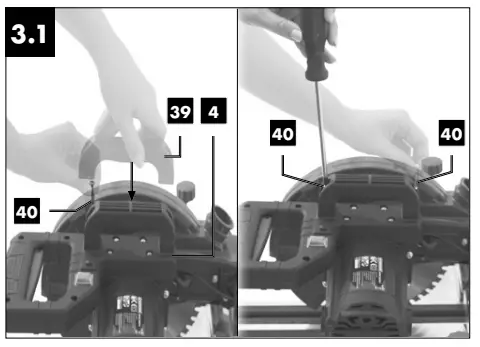
ATTENTION! The correct position of the transport handle (39) is specified by a groove.
- Mount the transport handle (39) on the machine head (4) using the Phillips screws 5.0 x 25 mm.
- Then tighten the two Phillips screws 5.0 x 25 mm (40) with a Phillips screwdriver (not included in the scope of delivery).
Setting up the machine 
- The machine must be set up where it can stand securely.
- Secure the machine on a workbench, base frame or similar.
- Insert 4 screws (not included in the scope of delivery) into the holes on the fixed saw table (15).
- Tighten up the screws.
Installing the tilt protection
- Loosen the tilt protection (36) pre-installed at the bottom of the saw.
- Pull the tilt protection (36) out, so that it can still be fixed with the aid of the Allen screws.
- Secure the tilt protection again with an Allen key (D).
Setting the adjustment screw 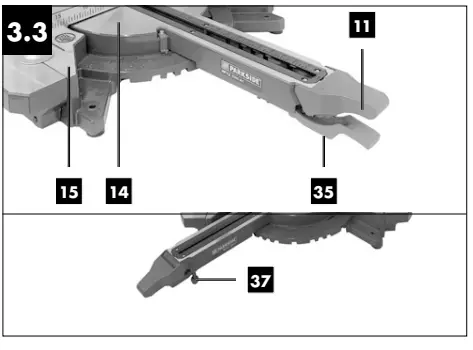
- Set the adjustment screw (37) to the level of the tabletop to avoid wobbling of the machine.
General information
- All covers and safety devices have to be properly fitted be-fore the equipment is switched on.
- It must be possible for the blade to run freely.
- When working with wood that has been processed before, watch out for foreign bodies such as nails or screws, etc.
- Before you press the ON/OFF switch check that the saw blade is fitted correctly. Moving parts must run smoothly.
- Before you connect the equipment to the power supply make sure the data on the rating plate are identical to the mains data.
Checking the moving saw blade guard safety device (5)
The saw blade guard protects against accidental contact with the saw blade and from chips flying around.
Check function
To do so, fold the saw downwards:
- The saw blade guard must provide free access to the saw blade without touching other parts.
- When folding the saw upwards into the starting position, the saw blade guard must cover the saw blade automatically.
Attachment
You need:
- 1x Allen key 6 mm (C)
- 1x Allen key 3 mm (D) (included in the scope of delivery)
- 1x open-ended spanner 13 mm
- 1x Phillips screwdriver (not included in the scope of delivery)
Attaching the multifunction sliding crosscut mitre saw
- In order to adjust the rotary table (14), fold the locking han-dle (11) upwards and pull up the latched position lever (35) with your index finger.
- Turn the rotary table (14) and pointer (12) to the desired angle measurement of the scale (13). To fix the setting, fold the locking handle (11) downwards.
- Press the machine head (4) lightly downwards and remove the locking bolt (23) from the motor bracket. Thus, the saw disengages from the lowest position.
- Swing the machine head (4) up.
- It is possible to secure the clamping devices (7) to the left or right on the fixed saw table (15). Insert the clamping devices (7) into the holes provided on the back of the stop rail (16) and secure them with the wing screws (7a).
For 0°- 45° mitre cuts, the clamping device (7) must only be mounted on the right side (see fig. 14-15). - It is possible to tilt the machine head (4) a max. 45° to the left by loosening the set screw (22).
- Workpiece supports (8) must always be secured and used during work. Define the desired table size (see 9.1.1.)
Defining the table size
- Loosen the set screw (9).
- Pull out the workpiece support (8) to the desired table size.
- Tighten the set screw (9) again.
Chip collection bag
The saw is equipped with a chip collection bag (17) for saw-dust and chips.
Attention! The chip collection bag may only be used when cutting wood and wood-like materials! When cutting metal, there is a risk that hot chips will ignite the chip collection bag. Squeeze the wings of the metal ring on the chip collection bag (17) together and slide it over the extraction port (17a) near the engine. The chip collection bag (17) can be emptied by means of a zipper at the bottom.
Connection to an external dust extractor
- Attach the extraction hose of a workshop vacuum cleaner to the extraction port (17a).
- The workshop vacuum cleaner must be suitable for the mate-rial being worked.
Attention! Always observe the safety and warning notices of the workshop vacuum cleaner being used. - When vacuuming dust that is especially detrimental to health or carcinogenic, use a special vacuum cleaner.
Precision adjustment of the stop for crosscut 90°
- No stop angle included.
- Lower the machine head (4) and secure it using the locking bolt (23).
- Loosen the set screw (22).
- Position the angle stop (A) between the saw blade (6) and the rotary table (14).
- Loosen the lock nut (26a).
- Adjust the adjusting screw (26) until the angle between the saw blade (6) and rotary table (14) is 90°.
- Re-tighten the lock nut (26a).
- Subsequently check the position of the angle indicator. If necessary, loosen the pointer (19) using a Philips screwdriver, set to position 0° on the angle scale (18) and re-tighten the retaining screw.
Precision adjustment of the stop for mitre cut 45°
- No stop angle included.
- Lower the machine head (4) and secure it using the locking bolt (23).
- Fix the rotary table (14) in the 0° position.
Attention! For mitre cuts (inclined saw head), the moveable stop rail (16a) must be fixed in the outer position (left side). - Open the set screw (16b) for the moveable stop rails (16a) and push the moveable stop rails (16a) outwards.
- The moveable stop rails (16a) must be locked so that the distance between the stop rails (16a) and the saw blade (6) is no more than 8 mm.
- The moveable stop rail (28) must be fixed in the inner posi-tion (right side).
- Before making the cut, check that no collision can occur be-tween the stop rails (16a) and the saw blade (6).
- Loosen the set screw (22) and use the handle (1) to angle the machine head (4) 45° to the left.
- 45° – position angle stop (B) between the saw blade (6) and rotary table (14).
- Loosen the lock nut (27a) and adjust the adjustment screw (27) until the angle between the saw blade (6) and the rotary table (14) is precisely 45°.
- Re-tighten the lock nut (27a).
- Subsequently check the position of the angle indicator. If necessary, loosen the pointer (19) using a Philips screwdriver, set to position 45° on the angle scale (18) and re-tighten the retaining screw.
Operation
Using the laser / LED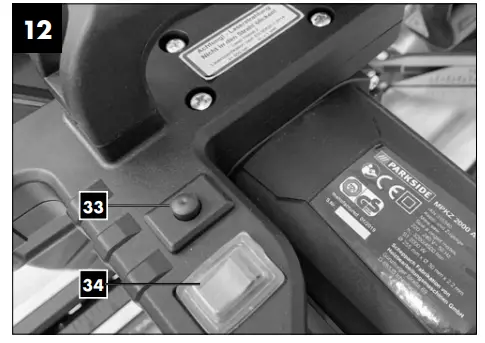

Changing the speed
The mitre saw has 2 speed ranges:
- To operate the mitre saw at a speed of 3200 rpm (metal), set the speed regulation switch (34) to position I.
- To operate the saw at a speed of 5000 rpm (wood), set the speed regulation switch (34) to position II.
Limiting the cutting depth (cutting grooves)
WARNING
Risk of kickback! When cutting grooves, it is particularly important that no lateral pressure is exerted on the saw blade. Otherwise, the saw head might suddenly kick back! Use a clamping device when cutting grooves. Avoid lateral pres-sure on the saw head.
- The cutting depth can be infinitely adjusted using the screw (24). To do this, loosen the knurled nut (24a) on the screw (24). Turn the screw (24) in or out to set the required cutting depth. Then re-tighten the knurled nut (24a) on the screw (24).
- Check the setting by completing a test cut.
Crosscut 90° and turntable 0°
In the case of cutting widths up to approx. 100 mm it is possible to fix the traction function of the saw with the set screw (20) in the rear position. In this position the machine can be operated in cross cutting mode. If the cutting width is over 100 mm then it is necessary to ensure that the set screw (20) is loose and the machine head (4) can move.
Attention! For 90° crosscuts, the moveable stop rail (16a) must be fixed in the inner position.
- Open the set screw (16b) for the moveable stop rails (16a) and push the moveable stop rails (16a) inwards.
- The moveable stop rails (16a) must be locked so that the distance between the stop rails (16a) and the saw blade (6) is no more than 8 mm.
- Before making the cut, check that no collision can occur be-tween the stop rails (16a) and the saw blade (6).
- Re-tighten the set screw (16b).
- Move the machine head (4) to its upper position.
- Use the handle (1) to push back the machine head (4) and fix it in this position if required (dependent on the cutting width).
- Place the piece of wood to be cut at the stop rail (16) and on the turntable (14).
- Secure the material with the clamping device (7) on the fixed saw table (15) to prevent it from shifting during the cutting process.
NOTE: Only use the left clamping device (7)! - Release the lock switch (3) and press the ON/OFF switch
(2) to start the motor. (Refer also to point 10.2 “Changing the speed” in this regard.) - With the drag guide (21) fixed in place (21): Use the handle (1) to move the machine head (4) steadily and with light pressure downwards until the saw blade (6) has completely cut through the work piece.
- With the drag guide (21) not fixed in place (21): Pull the machine head (4) all the way to the front. Lower the handle (1) to the very bottom by applying steady and light downward pressure. Now push the machine head (4) slowly and steadily to the very back until the saw blade (6) has completely cut through the work piece.
- When the cutting operation is completed, move the machine head back to its upper (home) position and release the ON/OFF button (2).
Attention! The machine executes an upward stroke auto-matically due to the return spring, i. e. do not release the han-dle (1) after completing the cut; instead allow the machine head to move upwards slowly whilst applying light counter pressure.
Crosscut 90° and turntable 0° – 45°
The multifunction sliding crosscut mitre saw can be used to make crosscuts of 0° -45° to the left and 0° -45° to the right in relation to the stop rail.
Attention! For 90° crosscuts, the moveable stop rail (16a) must be fixed in the inner position.
- Open the set screw (16b) for the moveable stop rails (16a) and push the moveable stop rails (16a) inwards.
- The moveable stop rails (16a) must be locked so that the distance between the stop rails (16a) and the saw blade (6) is no more than 8 mm.
- Before making the cut, check that no collision can occur be-tween the stop rails (16a) and the saw blade (6).
- Secure the set screw (16b) again.
- Loosen the locking handle (11) if tightened. Pull up the latched position lever (35) with your index finger and use the locking handle (11) to set the rotary table (14) to the desired angle (fig. 3.3+4).
- The pointer (12) on the rotary table must match the desired angle on the scale (13) on the fixed saw table (15).
- Re-tighten the locking handle (11) to secure the rotary table (14)(fig. 3.3+4).
- Cut as described under section 10.4.
Mitre cut 0°- 45° and turntable 0°
The multifunction sliding cross cut mitre saw can be used to make mitre cuts of 0° – 45° in relation to the work face. Attention! For 0°- 45° mitre cuts, the clamping device (7) must only be mounted on the right side (see fig. 14-15). Attention! For mitre cuts (inclined saw head), the moveable stop rail (16a) must be fixed in the outer position (left side).
- Open the set screw (16b) for the moveable stop rails (16a) and push the moveable stop rails (16a) outwards.
- The moveable stop rails (16a) must be locked so that the distance between the stop rails (16a) and the saw blade (6) is no more than 8 mm.
- The moveable stop rail (16a) must be fixed in the inner position (right side).
- Before making the cut, check that no collision can occur between the stop rails (16a) and the saw blade (6).
- Secure the set screw (16b) again.
- Move the machine head (4) to the top position.
- Fix the rotary table (14) in the 0° position.
- Loosen the set screw (22).
- Use the handle (1) to angle the machine head (4) to the left, until the pointer (19) indicates the desired angle measurement on the scale (18).
- Re-tighten the set screw (22).
- Cut as described in section 10.4.
Mitre cut 0°- 45° and turntable 0°- 45°
The multifunction sliding cross cut mitre saw can be used to make mitre cuts to the left of 0°- 45° in relation to the work face and, at the same time, 0° – 45° to the left or 0° – 45° to the right in relation to the stop rail (double mitre cut). Attention! For 0°- 45° mitre cuts, the clamping device (7) must only be mounted on the right side (see fig. 14-15). Attention! For mitre cuts (inclined saw head), the moveable stop rail (16a) must be fixed in the outer position (left side).
- Open the set screw (16b) for the moveable stop rails (16a) and push the moveable stop rails (16a) outwards.
- The moveable stop rails (16a) must be locked so that the distance between the stop rails (16a) and the saw blade (6) is no more than 8 mm.
- Before making the cut, check that no collision can occur be-tween the stop rails (16a) and the saw blade (6).
- Re-tighten the set screw (16b).
- Move the machine head (4) to its upper position.
- Fold the locking handle (11) upwards to loosen the rotary table (14) (fig. 3.3+4).
- Set the rotary table (14) to the desired angle (refer also to point 10.5 in this regard).
- Fold the locking handle (11) downwards to secure the rotary table (14) (fig. 3.3+4).
- Undo the set screw (22).
- Use the handle (1) to tilt the machine head (4) to the left until it coincides with the required angle value (in this connection see also section 10.6).
- Re-tighten the set screw (22).
- Cut as described under section 10.4.
Transport
- Tighten the locking handle (11) to lock the rotary table.
- Press the machine head (4) downwards and secure with the locking bolt (23).
- Fix the saw’s drag function with the locking screw for drag guide (20) in rear position.
- Carry the machine by the transport handle (39) and the fixed saw table (15).
- When reassembling the equipment proceed as described under section 8.
Maintenance
Warning! Prior to any adjustment, maintenance or service work disconnect the mains power plug!
General maintenance measures
Wipe chips and dust off the machine from time to time using a cloth. When cleaning the plastic do not use corrosive products.
Cleaning the moving saw blade guard safety device (5)
Always check the saw blade guard for debris before using the machine.
Remove old sawdust and splinters using a brush or similar tool.
Replacing the table insert
Danger!
With a damaged table insert (10) there is a risk of small parts getting stuck between table insert and saw blade, blocking the saw blade.
Immediately replace damaged table inserts!
- Swing the machine head (4) upwards and lock with the lock-ing bolt (23).
- Use one hand to insert the Allen key (C) in the flange screw (28).
- Firmly press the saw shaft lock (30) and slowly rotate the flange screw (28) in clockwise direction. The saw shaft lock (30) engages after no more than one rotation.
- Now, using a little more force, slacken the flange screw (29) in the clockwise direction.
- Turn the flange screw (28) right out and remove the outer flange (29).
- Fold the saw blade guard (5) upwards.
- Take the blade (6) off the inner flange (31) and pull out downwards.
- Carefully clean the flange screw (28), outer flange (29) and inner flange (31).
- Fit and fasten the new saw blade (6) in reverse order.
- Attention! The cutting angle of the teeth, in other words the direction of rotation of the saw blade (6) must coincide with the direction of the arrow on the housing.
- Before continuing your work make sure that all safety de-vices are in good working condition.
- Attention! Every time that you change the saw blade (6), check to see that it spins freely in the table insert (10, fig. 1) in both perpendicular and 45° angle settings.
- Attention! The work to change and align the saw blade (6) must be carried out correctly.
Adjusting the laser
If the laser (32) ceases to indicate the correct cutting line, you can readjust the laser.
- Loosen the Phillips screws (E).
- Set the laser by moving sideways until the laser beam strikes the teeth of the saw blade (6).
- Firmly secure both screws (E).
Brush inspection
Check the carbon brushes after the first 50 operating hours with a new machine, or when new brushes have been fitted. After carrying out the first check, repeat the check every 10 operating hours.
If the carbon is worn to a length of 6 mm, or if the spring or contact wire are burned or damaged, it is necessary to replace both brushes. If the brushes are found to be usable following removal, it is possible to reinstall them.
When servicing the carbon brushes, open the two latches coun-terclockwise (as shown in figure 20). Then remove the carbon brushes. Replace the carbon brushes in the reverse order.
Service information
Please note that the following parts of this product are sub-ject to normal or natural wear and that the following parts are therefore also required for use as consumables.
Wear parts*: carbon brushes, saw blade, table insert black (art. no. 5901215010), chip collection bagNot necessarily included in the scope of delivery!
Storage
Store the device and its accessories in a dark, dry and frost-proof place that is inaccessible to children. The optimum storage temperature is between 5 and 30˚C. Store the electrical tool in its original packaging.
Cover the electrical tool in order to protect it from dust and moisture. Store the operating manual with the electrical tool.
Electrical connection
The electrical motor installed is connected and ready for operation. The connection complies with the applicable VDE and DIN provisions. The customer’s mains connection, as well as the extension ca-ble used, must also comply with these regulations.
Important information
In the event of an overloading the motor will switch itself off. After a cool-down period (time varies) the motor can be switched back on again.
Damaged electrical connection cable
The insulation on electrical connection cables is often dam-aged. This may have the following causes:
- Passage points, where connection cables are passed through windows or doors.
- Kinks where the connection cable has been improperly fas-tened or routed.
- Places where the connection cables have been cut due to being driven over.
- Insulation damage due to being ripped out of the wall outlet.
- Cracks due to the insulation ageing.
Such damaged electrical connection cables must not be used and are life-threatening due to the insulation damage. Check the electrical connection cables for damage regularly. Make sure that the connection cable does not hang on the power network during the inspection.
Electrical connection cables must comply with the applicable VDE and DIN provisions. Only use connection cables of the same designation. The printing of the type designation on the connection cable is mandatory.
If the power cord of this device is damaged, it must be replaced by a special power cord, which is available from the manufac-turer or its service department.
AC motor
The mains voltage must be 220 – 240 V~.
- Extension cables up to 25 m long must have a cross-section of 1.5 mm2.
Connections and repairs of electrical equipment may only be carried out by an electrician. Please provide the following information in the event of any enquiries:
- Type of current for the motor
- Machine data – type plate
Disposal and recycling
The equipment is supplied in packaging to prevent it from be-ing damaged in transit. The raw materials in this packaging can be reused or recycled. The equipment and its accessories are made of various types of material, such as metal and plastic. Defective components must be disposed of as special waste. Ask your dealer or your local council. The packaging is wholly composed of environmentally-friendly materials that can be disposed of at a local recycling centre. Contact your local refuse disposal authority for more details of how to dispose of your worn-out electrical devices. Old devices must not be disposed of with household waste!
This symbol indicates that this product must not be dis-posed of together with domestic waste in compliance with the Directive (2012/19/EU) pertaining to waste electrical and electronic equipment (WEEE). This product must be disposed of at a designated collection point. This can occur, for example, by handing it in at an authorised col-lecting point for the recycling of waste electrical and electronic equipment. Improper handling of waste equipment may have negative consequences for the environment and human health due to potentially hazardous substances that are often contained in electrical and electronic equipment. By properly disposing of this product, you are also contributing to the ef-fective use of natural resources. You can obtain information on collection points for waste equipment from your municipal administration, public waste disposal authority, an authorised body for the disposal of waste electrical and electronic equip-ment or your waste disposal company.
Troubleshooting
| Fault | Possible cause | Remedy |
| Motor does not work | Motor, cable or plug defective, the mains circuit breaker switched off | Arrange for inspection of the machine by a specialist. Never repair the motor yourself. Danger!
Check fuses and replace as necessary. |
| The motor starts up slowly and does not reach operating speed. | Voltage too low, coils damaged, capacitor burnt | Contact an electrician to check the voltage. Arrange for inspection of the motor by a specialist.
Arrange for replacement of the capacitor by a special- ist. |
| Motor makes excessive noise | Coils damaged, motor defective | Arrange for inspection of the motor by a specialist |
| The motor does not reach its full power. | Circuits in the network are overloaded (lamps, other motors, etc.) | Do not use any other equipment or motors on the same circuit |
| Motor overheats easily. | Overloading of the motor, insufficient cooling of the motor | Avoid overloading the motor while cutting, remove dust from the motor in order to ensure optimal cooling of the motor |
| Saw cut is rough or wavy | Saw blade dull, tooth shape not appropriate for the material thickness | Re-sharpen saw blade and/or use suitable saw blade |
| Workpiece pulls away and/or splinters | Excessive cutting pressure and/or saw blade not suitable for use | Insert suitable saw blade |
Warranty certificate
Dear Customer,
All of our products undergo strict quality checks to ensure that they reach you in perfect condition. In the unlikely event that your device develops a fault, please contact our service department at the address shown on this guarantee card. Of course, if you would prefer to call us then we are also happy to offer our assistance under the service number printed below. Please note the following terms under which guarantee claims can be made:
- These guarantee terms cover additional guarantee rights and do not affect your statutory warranty rights. We do not charge you for this guarantee.
- Our guarantee only covers problems caused by material or manufacturing defects, and it is restricted to the rectification of these de-fects or replacement of the device. Please note that our devices have not been designed for use in commercial, trade or industrial ap-plications. Consequently, the guarantee is invalidated if the equipment is used in commercial, trade or industrial applications or for other equivalent activities. The following are also excluded from our guarantee: compensation for transport damage, damage caused by failure to comply with the installation/assembly instructions or damage caused by unprofessional installation, failure to comply with the operating instructions (e.g. connection to the wrong mains voltage or current type), misuse or inappropriate use (such as overload-ing of the device or use of non-approved tools or accessories), failure to comply with the maintenance and safety regulations, ingress of foreign bodies into the device (e.g. sand, stones or dust), effects of force or external influences (e.g. damage caused by the device being dropped) and normal wear resulting from proper operation of the device. The guarantee is rendered null and void if any attempt is made to tamper with the device.
- The guarantee is valid for a period of 3 years starting from the purchase date of the device. Guarantee claims should be submitted before the end of the guarantee period within two weeks of the defect being noticed. No guarantee claims will be accepted after the end of the guarantee period. The original guarantee period remains applicable to the device even if repairs are carried out or parts are replaced. In such cases, the work performed or parts fitted will not result in an extension of the guarantee period, and no new guarantee will become active for the work performed or parts fitted. This also applies when an on-site service is used.
- In order to assert your guarantee claim, please contact the service partner shown below. If the complaint is within the guarantee pe-riod, we will provide you with a return slip, with which you can return your defective device free of charge to us. It would help us if you could describe the nature of the problem in as much detail as possible. If the defect is covered by our guarantee then your device will either be repaired immediately and returned to you, or we will send you a new device.
Of course, we are also happy offer a chargeable repair service for any defects which are not covered by the scope of this guarantee or for units which are no longer covered. To take advantage of this service, please send the device to our service address.
Service-Hotline (GB):
+800 4003 4003
(0,00 EUR/Min.)
Service-Email (GB):
[email protected]
Service Address (GB):
Forest Park & Garden
Coed Court, Taffsmead Road
Treforest, Ind. Estate, Pontypridd CF375SW
At www.lidl-service.com you can download this and many more manuals, product videos plus installation software.
The QR code takes you directly to the Lidl service page (www.lidl-service.com) and you can open your operating manual by entering the article number (IAN) 360564_2010.

